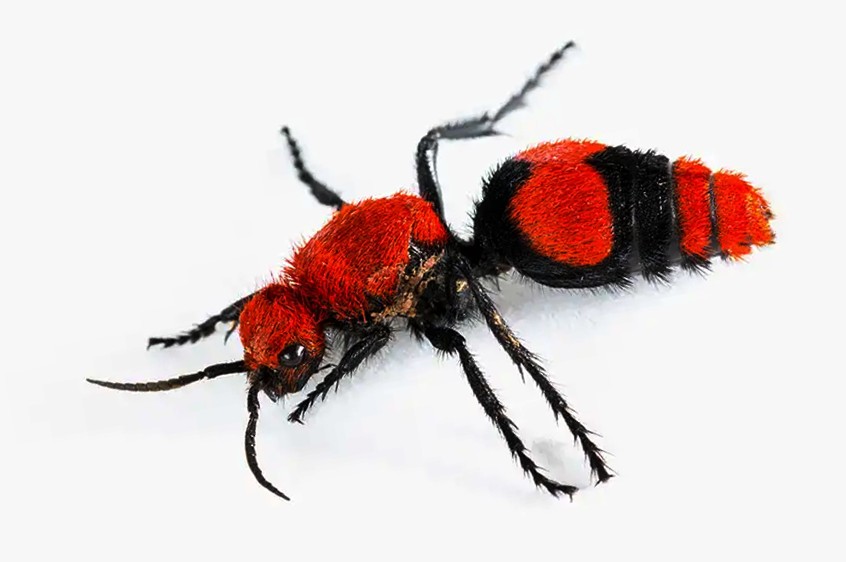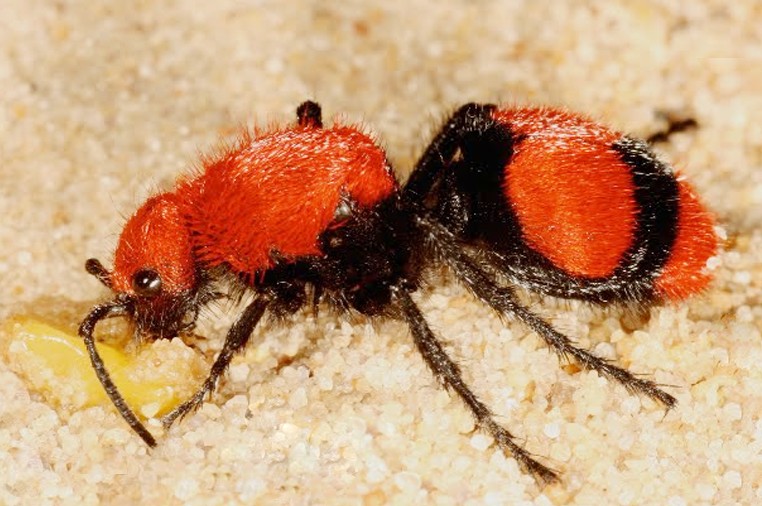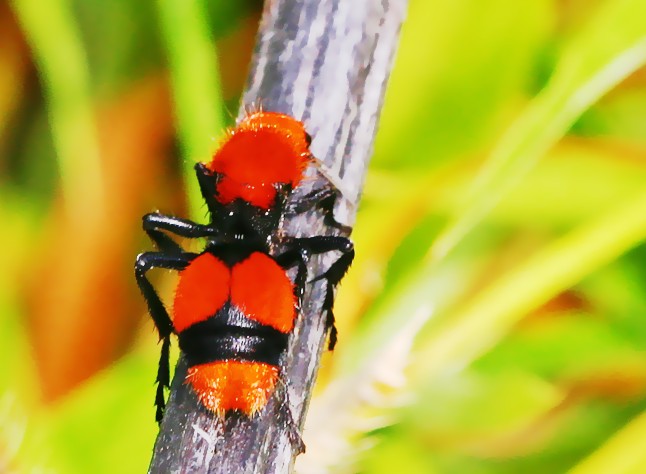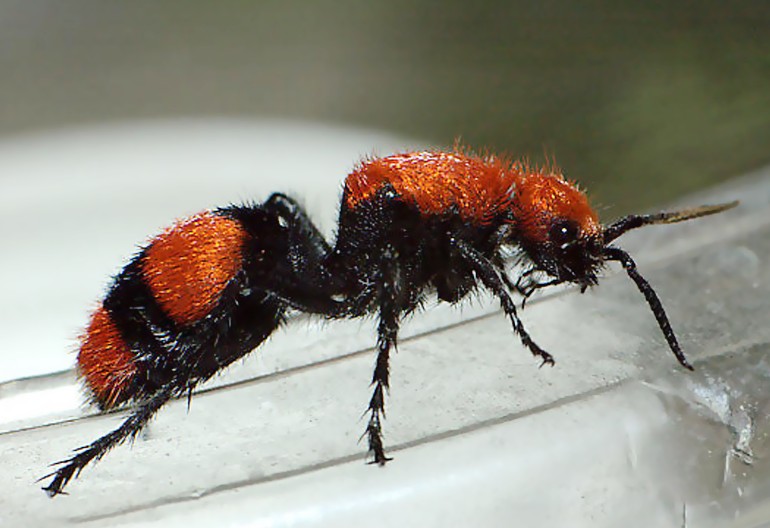Red Velvet Ants
What are Red Velvet Ants?
Red Velvet Ants are also referred to as the red wasps, velvet ants, and cow killer ants. These brightly colored little monsters can cause a tremendous amount of pain with their stings. However, that is only true in case you are dealing with a female red velvet ant. These ants can’t fly and are really dangerous.

Picture of a Red Velvet Ant
The red velvet ants despite their names are actually wasps. Their name has the mention of velvet because of their fancy body color. They have earned their name of cow killer ant for the potential they have to kill a cow with their sting. Today, we will be focusing on every detail about the red velvet ant. So, are you ready to learn all about it?
How does the Red Velvet Ant look like?

Red Velvet Ants are not more than an inch in size. The young ones are of ¼ th inch in size. They are often confused with ants. Keep in mind they are wasps. The female red velvet ants don’t possess any wings. They are easily recognized by their strong and vibrant hues. The red velvet ants have orange and red stripes on its body that is covered in black. Though the males are capable of flying, the female red velvet ants are fast runners. The males possess two pairs of black colored, transparent wings. There is a hump and an elbowed antenna in the constriction right in the middle of the abdomen and thorax.
Habitat
They are most commonly spotted in the eastern regions of the United States of America. This particular species from the wasps’ family is found in Missouri, Connecticut, Texas, and Florida. These are the areas that you can quite easily locate the Dasymutilla Occidentalis or the cow killer ant.
What does the Red Velvet Ant Consume?
They feed themselves on adult ants the same way other species of the bees and wasp family does. However, they also suck on the nectar of flowers. The red velvet ants consume both adult and the larvae of insects. Their favourite food includes beetles, flies, wasps, and other bees. They won’t harm you unless you bother them. The male red velvet ant isn’t capable of biting, but the kind of excruciating pain the female red velvet ant produces is dangerous. Keep a safe distance from them and don’t approach them without proper precaution.
Life cycle
The cow killer ants have a complete life. They hatch from the eggs and proceeds its way to larvae, pupal, and adult stages. The female red velvet ant doesn’t build her own nest. It goes ahead and lays its eggs in the nests of other bees and wasps. They primarily target the nest of the bumblebees.
The larvae of the red velvet ants eat up the host larvae or the ones in whose nest it is growing. This happens right before they reach the pupa stage. The cow killer ants are renowned for the lives they lead. It is always in solitude that you will find these ants. Their sting is so painful that it can kill a huge, fully grown adult cow. Isn’t that hard to imagine?
How Dangerous are Red Velvet Ants?
If you have pronounced it as red velvet cake than ants, then you are about to be terrified at what you are going to learn now. The name is a horrible misinterpretation of their characteristics. Neither are the red nor do they have a velvety body. To top it all, they are not even ants. Belonging to a family of 3000 species, these wasps belong to the family of Mutillidae. The fuzzy cute names can’t hide the kind of dangerous monsters they can actually be. They are deadly to the cicada killer wasp.
They enjoy their life in solitude, roaming around in the lawn, digging the soil, or looking for food. Under no circumstances they initiate the first attack. When a human pokes it with bare hands or steps on it without wearing proper footwear, then the result can be excruciating pain. They are dangerous when instigated. Be very careful of them at all times.
Removal: How to Get Rid of the Red Velvet Ants?
These ants are renowned for their differentiated and attractive look which is created due to the presence of the orange and red colour combination on their body. The male red velvet ants have the potential to fly, but they are basically a harmless nuisance. On the other hand, it is the female red velvet ants that have the power to cause a tremendous amount of pain but are unable to fly.
These ants build nests and stay in colonies. Locating a single red velvet ant might not be of serious threats, however, if you find an entire colony of these buggers, then it is time to deal with the problem in hand because it will turn into a disaster in no time. Check out the following ways you can take care of them.
1. Find out where they are staying
If you spot one red velvet ant in your home, keep in mind there is a high chance it is not alone. Try to locate the spot where the red velvet ants have built their nest. You are bound to find a trail of red velvet ants emerging from a small corner of your home or garden. It is there that it has laid eggs. Once you know where they are coming from to infiltrate your homes, it will become an easier task to deal with them.
2. Take care of their nests
A red velvet ant doesn’t ever build its own nest. They are infamous for their lazy, laid back attitude. These ants go ahead and lay their eggs in the nest of a bumblebee. Apart from using the bumblebee’s nest as its own home they also go ahead to mercilessly kill all the young ones in the nest.
If you locate the nest of a bumblebee, then the chances of it being a nest for a red velvet ant is high. Use a strong insecticide that clearly mentions it can kill red velvet ants to get rid off the bumblebees nest. Remember to take extreme precaution and always wear a mask and gloves. If it feels too difficult for you, don’t hesitate to call a professional for help. Once the nest has been removed, chances of red velvet ants bothering you will subside.
3. Stamp it
Yeah, sounds a bit odd. But that is actually an effective way of dealing with the red velvet ants. The second you spot them ideally roaming around your house or inside it, crush them. You have to remember that these ants can inflict nerve-wracking pain, so it is advised to wear protective shoes before you do that.
4. Make use of the wasp spray
Wasp sprays are incredibly effective when it comes to protecting your home from red velvet ants. It is one of the best and most powerful ways to deal with the red velvet ant problem. If you find an ant roaming around in your home in solitude, all you have to do is spray it. You can even use it without spotting them. If there are any cracks or openings in your home, then don’t forget to use it right there.
5. The use of insecticides
Tracing a red velvet ant colony is only bad news. All you have to do is smear them with insecticides. Nurseries and pest control stores sell strong and effective insecticides that can take care of the red velvet ants.
6. Borax
The most popular way of dealing with the ant infestation problem is by killing them with borax. Prepare a bait for the ants, by mixing equal quantities of boric powder and sugar. The smell of sugar will attract the ants and they will die by consuming the borax.
7. Let the grass grow
Yes, we are absolutely sure about this extraordinary remedy that will take care of the red velvet ants in your garden. How? The tall grasses prevent these beauties from building their nest. They won’t be able to stay under the soil. Therefore, try to maintain the foliage on your garden soil.
8. Don’t let water accumulate near your house
The red velvet ants love to live beside a stagnant water body that will offer them the water they need to survive.
When you get rid of the source of water, you prevent them from enjoying their natural habitat. This is an extremely effective method of controlling the red velvet ants. Keep in mind to take care of the stagnant water problem around your home.
If the infestation is beyond your control, then it is advisable to reach out to an expert pest control company. Sometimes, it can be a real challenge to deal with the red velvet ants, and it is better to leave the matters in the hands of a professional. So, that’s everything that you needed to know about red velvet ants.
Pictures
Take a look at some of the magnificent Pictures of Red Velvet Ants:




